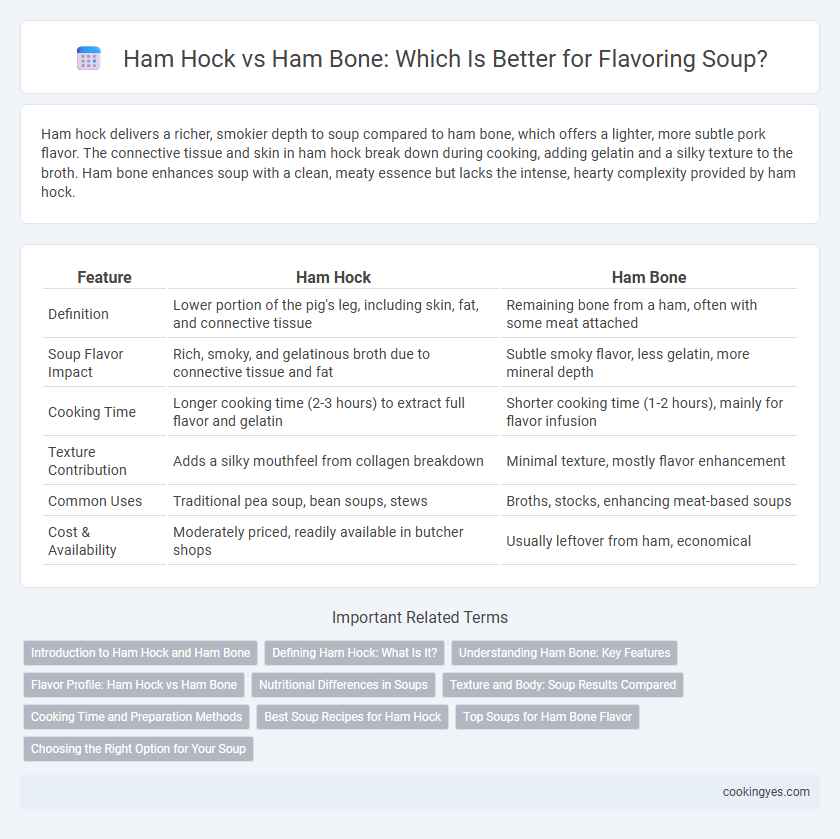Ham hock delivers a richer, smokier depth to soup compared to ham bone, which offers a lighter, more subtle pork flavor. The connective tissue and skin in ham hock break down during cooking, adding gelatin and a silky texture to the broth. Ham bone enhances soup with a clean, meaty essence but lacks the intense, hearty complexity provided by ham hock.
Table of Comparison
| Feature | Ham Hock | Ham Bone |
|---|---|---|
| Definition | Lower portion of the pig's leg, including skin, fat, and connective tissue | Remaining bone from a ham, often with some meat attached |
| Soup Flavor Impact | Rich, smoky, and gelatinous broth due to connective tissue and fat | Subtle smoky flavor, less gelatin, more mineral depth |
| Cooking Time | Longer cooking time (2-3 hours) to extract full flavor and gelatin | Shorter cooking time (1-2 hours), mainly for flavor infusion |
| Texture Contribution | Adds a silky mouthfeel from collagen breakdown | Minimal texture, mostly flavor enhancement |
| Common Uses | Traditional pea soup, bean soups, stews | Broths, stocks, enhancing meat-based soups |
| Cost & Availability | Moderately priced, readily available in butcher shops | Usually leftover from ham, economical |
Introduction to Ham Hock and Ham Bone
Ham hock, the joint connecting the pig's foot to the leg, is rich in collagen and connective tissue, making it ideal for imparting deep, smoky flavor and a gelatinous texture to soups. Ham bones, often leftover from ham cuts, contain marrow and residual meat that infuse broths with savory, robust taste while enhancing nutritional value. Using ham hocks or ham bones in soup stock elevates complexity and richness, with hocks offering more collagen and bones providing concentrated umami.
Defining Ham Hock: What Is It?
Ham hock, the joint between the pig's foot and leg, is prized for its rich, smoky flavor that deepens soups and stews. Unlike a ham bone, which primarily offers residual meat and marrow, ham hock contains dense connective tissue and skin that break down to create a gelatinous, savory broth. Commonly used in traditional Southern and European cuisines, ham hocks impart a robust umami complexity essential for authentic flavor profiles.
Understanding Ham Bone: Key Features
Ham bone plays a crucial role in enriching soup flavor, offering a deep, smoky taste derived from the marrow and connective tissues. Unlike ham hock, which contains more meat and a slightly different texture, ham bone provides a more concentrated and robust broth base. Utilizing ham bones in soup ensures a rich umami profile and gelatinous consistency, enhancing both aroma and mouthfeel.
Flavor Profile: Ham Hock vs Ham Bone
Ham hocks deliver a richer, smoky, and slightly salty flavor to soups due to their higher fat content and connective tissue, which break down during slow cooking. Ham bones provide a more subtle, savory umami flavor with less fat, contributing a cleaner broth ideal for lighter soups. Using ham hocks intensifies the overall depth, while ham bones offer a balanced, less overpowering broth base.
Nutritional Differences in Soups
Ham hock imparts a richer, more gelatinous texture to soups due to its higher collagen content, while contributing essential nutrients like vitamin B6 and iron. Ham bones provide a milder flavor but are also valuable for minerals such as calcium and phosphorus released during simmering. Nutritionally, ham hocks enhance protein and micronutrient density in broth, whereas ham bones primarily fortify mineral content without significantly boosting protein levels.
Texture and Body: Soup Results Compared
Ham hock imparts a richer, gelatinous texture to soup due to its higher collagen content, resulting in a thicker, more velvety body. In contrast, ham bone provides a cleaner, lighter broth with less unctuous mouthfeel but a pronounced savory depth from residual meat and marrow. The choice between ham hock and ham bone significantly influences soup viscosity and overall mouth-coating satisfaction.
Cooking Time and Preparation Methods
Ham hock requires longer cooking times, typically simmering for 2-3 hours to fully release its rich, smoky flavor, while the ham bone usually needs about 1-2 hours to impart a milder taste to soups. Preparation methods for ham hocks often include slow-cooking or braising to break down tough connective tissue, whereas ham bones can be added directly to the pot after trimming excess fat. Using ham hocks enhances broth depth through collagen release and marrow infusion, whereas ham bones primarily contribute saltiness and subtle meat essence.
Best Soup Recipes for Ham Hock
Ham hock delivers a richer, smokier flavor compared to ham bone, making it ideal for hearty soups like split pea or black bean. The connective tissue and skin in ham hock break down during slow cooking to create a silky, gelatinous texture. Recipes such as ham hock and lentil soup or collard greens with ham hock maximize the depth of taste and mouthfeel.
Top Soups for Ham Bone Flavor
Ham hock delivers a rich, smoky depth that intensifies broth flavor, making it ideal for robust soups like split pea and navy bean. Ham bone imparts a milder, savory essence perfect for delicate soups such as potato and vegetable chowders. Soups like ham and lentil or collard greens benefit from the concentrated taste of ham hocks, enhancing umami and hearty satisfaction.
Choosing the Right Option for Your Soup
Ham hock delivers a richer, smokier flavor and tender meat, making it ideal for hearty soups like split pea or bean stew. Ham bone, often from the center cut, infuses a subtler taste, perfect for lighter broths and vegetable soups. Select ham hock for depth and robustness, or ham bone for a more delicate, balanced soup base.
Ham hock vs Ham bone for soup flavoring Infographic

 cookingyes.com
cookingyes.com